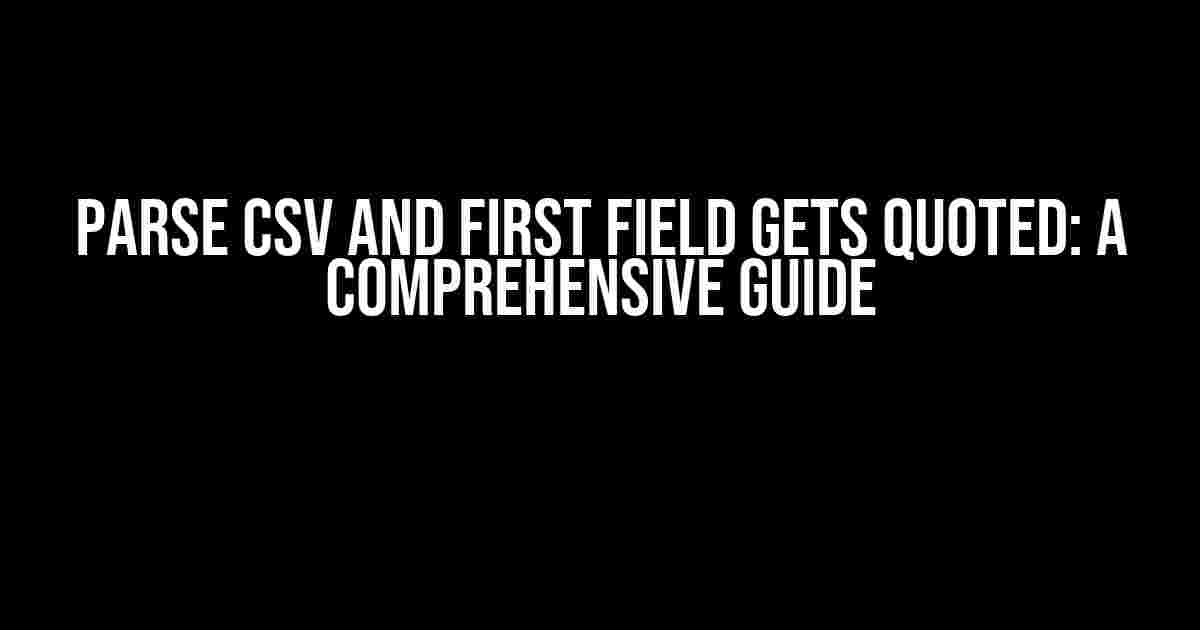Are you tired of dealing with quoted fields in your CSV files? Do you struggle to parse CSV data only to find that the first field gets quoted, throwing off your entire import process? Worry no more! In this article, we’ll take a deep dive into the world of CSV parsing and show you exactly how to handle quoted fields like a pro.
What’s the Deal with Quoted Fields?
In CSV files, quoted fields are used to enclose values that contain special characters, such as commas, newlines, or quotes themselves. This is necessary to prevent the CSV parser from misinterpreting the data and causing errors. However, when the first field gets quoted, it can cause a world of trouble.
The Problem with Quoted First Fields
Imagine you’re importing a CSV file into a database or spreadsheet, and the first field is a quoted string. Without proper handling, this can lead to:
- Inconsistent data formatting
- Data corruption or loss
- Import errors and failures
- Headaches and frustration!
Why Do First Fields Get Quoted in the First Place?
There are several reasons why the first field might get quoted in your CSV file. Some common culprits include:
- User error: Accidental quotes or incorrect formatting can lead to quoted first fields.
- Software or tool limitations: Certain software or tools may automatically quote the first field, even if it’s not necessary.
- Legacy data issues: Older CSV files or imports from other systems might contain quoted first fields.
Solution 1: Remove Quotes from the First Field
One way to handle quoted first fields is to simply remove the quotes. This can be done using a variety of methods, including:
import csv
with open('input.csv', 'r') as csvfile:
reader = csv.reader(csvfile)
for row in reader:
first_field = row[0].strip('"') # Remove quotes from the first field
print(first_field)
This approach is simple and effective, but it may not work in all cases, especially if the quotes are necessary to enclose special characters within the first field.
Solution 2: Use a CSV Parser with Quote Handling
A more robust approach is to use a CSV parser that can handle quoted fields correctly. Many programming languages, including Python, have built-in CSV parsing libraries that can handle quoted fields.
import csv
with open('input.csv', 'r') as csvfile:
reader = csv.reader(csvfile, quotechar='"', delimiter=',')
for row in reader:
print(row) # Print the entire row, including quoted fields
In this example, we’re using the `csv` module in Python to parse the CSV file. By specifying the `quotechar` parameter, we’re telling the parser to treat double quotes as the quote character. This allows the parser to correctly handle quoted fields, including the first field.
Solution 3: Use a CSV Library with Advanced Features
For more complex CSV parsing tasks, you may need to use a dedicated CSV library that offers advanced features, such as:
- pandas (Python): A powerful data analysis library that includes robust CSV parsing capabilities.
- csvkit (Python): A command-line tool for working with CSV files, including parsing and manipulation.
- OpenCSV (Java): A popular Java library for CSV parsing and generation.
These libraries often provide more advanced features, such as:
- Handling quoted fields with embedded newlines or quotes
- Support for custom quote characters or delimiters
- Data type conversion and validation
Best Practices for Working with Quoted CSV Fields
To avoid quoted first fields and other CSV parsing headaches, follow these best practices:
- Use a consistent quote character**: Choose a quote character and stick to it throughout your CSV file.
- Quote only when necessary**: Only quote fields that contain special characters or require enclosure.
- Test your CSV files**: Verify that your CSV files are correctly formatted and can be parsed successfully.
- Use a robust CSV parser**: Choose a CSV parser that can handle quoted fields correctly and provides advanced features for complex parsing tasks.
Conclusion
Parsing CSV files with quoted first fields doesn’t have to be a nightmare. By understanding the reasons behind quoted fields, using the right tools and techniques, and following best practices, you can ensure seamless CSV imports and avoid data corruption or loss. Remember, with great CSV power comes great CSV responsibility!
| Method | Description | Pros | Cons |
|---|---|---|---|
| Remove Quotes | Remove quotes from the first field | Simple, easy to implement | Might not work for fields with special characters |
| CSV Parser with Quote Handling | Use a CSV parser that handles quoted fields correctly | Robust, flexible, and accurate | May require programming knowledge |
| CSV Library with Advanced Features | Use a dedicated CSV library with advanced features | Highly customizable, powerful, and flexible | May have a steeper learning curve |
Now that you’ve mastered the art of parsing CSV files with quoted first fields, go forth and conquer the world of data imports!
Frequently Asked Question
Got stuck with parsing CSV files and that pesky first field getting quoted? Fear not, we’ve got the answers!
Why does the first field in my CSV file get quoted?
This happens because the parser assumes the first character is a delimiter, not a value. To fix this, you can either specify the delimiter explicitly or use a parsing library that handles this automatically, like pandas in Python.
How can I prevent the first field from being quoted in a CSV file?
One way is to add a header row to your CSV file, so the parser knows the first row contains column names, not data. Alternatively, you can specify the `quotechar` parameter when reading the CSV file, setting it to `None` or an empty string.
What parsing libraries can handle quoted fields correctly?
Libraries like pandas in Python, OpenCSV in Java, and CSVKit in Ruby are known to handle quoted fields correctly. They can automatically detect and remove quotes from fields, making your life easier.
Can I use a CSV parser that doesn’t quote the first field?
Yes, there are CSV parsers available that don’t quote the first field by default. For example, the `csv` module in Python’s standard library can be configured to not quote fields. You can also use a library like `unicodecsv` which provides more flexible quoting options.
How do I specify the delimiter when parsing a CSV file?
When parsing a CSV file, you can specify the delimiter using the `delimiter` or `sep` parameter, depending on the library you’re using. For example, in Python’s `pandas` library, you would use `pd.read_csv(‘file.csv’, delimiter=’,’)`. Similarly, in Java’s `OpenCSV` library, you would use `CSVReader(reader, ‘,’)`.


